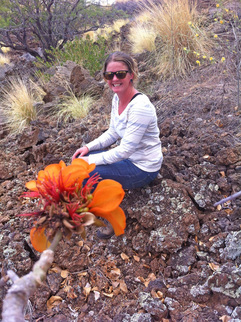 Photo by George Fuller
Photo by George Fuller The wiliwili is one of the last upper story trees still standing in an area once blanketed in dryland forest. It is said that at one time the forest made it possible for a person to travel the west side of the island without touching the ground. Now only a few sentinels of a time past dot the Waikoloa landscape, the boldly orange wiliwili with its delicate leaves and flowers, prominent among them.

The wake-up call came about when “10 or 12 years ago contractors were coming up to Waikoloa Village area and removing wiliwili trees and taking them down to properties at the resort,” said Lawson. This inspired members of Waikoloa Outdoor Circle (WOC) to seek a way to prevent any more transplanting, which eventually led to the formation of WDFI. “Everyone was pretty much in agreement that they would never allow that to happen again on this property,” said Lawson.
A testament to the can-do spirit of aloha, “People in the community saw something that needed protecting and they figured out how to get a lease, find the money and the right people to write the plans and manage the projects,” observed Lawson, who became one of those “right people”. An environmental biologist working at the Pohakuloa Training Area, Lawson arrived on the scene as a volunteer and when the organization was formed became its project manager.
 Jen Lawson
Jen Lawson From the beginning WDFI has been a collaborative effort. “You have people, maybe their family are lineal descendants on this land forever, cultural practitioners or scientists and when you bring those people together it’s the most productive way,” said Lawson.
Like tree roots that create a network of support, the preserve community is expanding. Last year, with regular Saturday workdays, the preserve drew over 1500 volunteers. “We clear the grass and do some of the hard stuff and then we bring in the community to plant the trees. Volunteers do a great job. We've had survival rates as high as 90%,” said Lawson.
WDFI is also enhancing the future for Waikoloa Village. “We're really creating a community here. We're bringing conservation to the forefront in Waikoloa and we're involving our community. Every 3rd grader comes out here and gets to learn about the dry forest in their own back yard,” said Lawson.
Coming up on its fifth year WDFI continues to expand its educational offering with programs for Hawai`i Island school groups as well as mainland colleges. One such program Future Foresters, dreamt up by WDFI board president Beverly Brand, is a Saturday program for 4th and 5th graders that brings students out to the forest. “They learn about Hawaiian culture and do traditional crafts, along with natural history and the plant species we have here and just be out here and explore. Go see what it’s like to be in a cave,” said Lawson.
 Hi'ialo with visitors fall 2014
Hi'ialo with visitors fall 2014 The WDFI currently holds a 75 year lease on 275 acres just S.W. of Waikoloa Village, zoned as a protected preserve. Lawson met me at the Quarry road turn off. Bumping down the rugged road and through the entrance gate, I’m introduced to Hi`ialo (beloved), a welcoming burst of color and the apparent Waikoloa wiliwili matriarch.
Now completely fenced to exclude ungulates, oases of plant communities colonize the jagged rubble strewn landscape. Uhiuhi growing companionably with keawe, sheltering volunteer ilima, while solitary wiliwili, each with their unique tangle of limbs preside over ridgelines.
 Uhiuhi tree
Uhiuhi tree Wiliwili was an important plant due to its low density and was used to make surfboards, fishing floats and ama (outrigger arm). “Wiliwili is testament to how tough Native Hawaiian species can be. These trees have maybe been here since it was a forest. We grow hundreds of wiliwili trees every year from Waikoloa seeds. Students came out here, collected seeds, learned about how seeds germinate, germinated the seeds and then they came back and planted,” said Lawson.
While wiliwili was the catalyst for creating the preserve, initial inventories revealed some surprises, such as the discovery of an almost extinct plant species, the uhiuhi. One of the reasons the wiliwili needs protection is that it’s not listed as endangered, but the native uhiuhi is. It’s estimated that there are only 75 uhiuhi trees on Hawai`i Island and 13 of those reside in the WDFI preserve.
At one time the uhiuhi was an important source of material for traditional crafts. The wood of this native is so dense that it sinks in water and so strong that it was used to make tools such as the o`o (digging pole) and weapons. “Part of the festival is recreating some of these really valuable things to show people how they are made and share some background,” said Lawson.
Other plants include koai`a, a dry forest cousin of koa; ko`oloa`ula, a rare shrub whose beautiful red blossom was used for lei; and halapepe, which was once one of the most common trees between Kohala and Kona. “They’re delicious. I’ve heard of paniolo breaking them off and feeding them to their horses,” said Lawson.
Some of the preserve plants, such as naupaka, koa, koai`a and wiliwili, grown in the small on-site nursery, will be going home with festival participants. “Part of the festival is so people can grow natives in their own neighborhoods. You got to grow it to know it,” said Lawson.
The Wiliwili festival will celebrate the dry forest and “…get people together to talk about the unique environment in Waikoloa. We bring people from all over the island who are doing similar work and are contributing to the health and wellness of the ecosystem,” said Lawson.

 RSS Feed
RSS Feed
